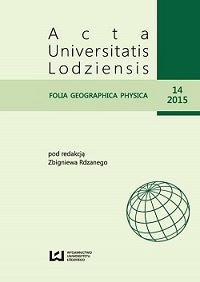Spatial variability of precipitation in the area of Lodz
DOI:
https://doi.org/10.18778/1427-9711.14.01Keywords:
precipitations, urban area, Lodz, spatial variabilityAbstract
This study is an attempt to determine the spatial variability of precipitation in the city of Lodz, within its administrative boundaries, and it’s a part of the larger project, which aims to develop an integrated river outflow model under a strong anthropopressure. Therefore, the hydrologic year was taken (from November 1 to October 31). To accomplish this task, the data recorded in 2010–2012 by various institutions operating within the agglomeration were used (fig. 1). Data strings from 24 rain gauges were used. However, the obtained sequences were characterized by discontinuity and the existence of various origin errors and different character. Therefore, the first task was to detect and fill the measurement gaps or to correct them. The ultimate aim of the present study was to obtain a cartographic representation of the spatial variability of precipitation in each year of the period 2010–2012 (fig. 3) and their average annual throughout this period (fig. 4), which made it possible to determine the spatial variability of water flow to the surface. Figs. 5 and 6 represent respectively the maximum daily rainfall and maximum hourly rainfall recorded in the investigated three-year period. Fig. 7 shows the average annual number of days with precipitation in the city area. Despite the very dense measurement network (which continues to be expanded) and a very high resolution of data, it was a difficult task, which required multi-step preparation and verification procedures. Data strings were incomplete or affected by errors of various kinds. One must therefore be aware of the imperfections of data collected automatically. Studies on spatial distribution of precipitation, their duration and intensity can be used to understand the causes and learn the scope of urban flooding. Creation of storm sewers control system which reacts in real-time to readings of automatic stations will avoid future losses related to sudden urban floods.
Downloads
References
Bac, S., Rojek, M., 1981. Meteorologia i klimatologia. Warszawa, 1–250.
Google Scholar
Boryczka, J., 1977. Empiryczne równania klimatu Polski. Rozprawy UW 86. Wydawnictwo UW, Warszawa, 1–287.
Google Scholar
Budzyński, I., 2013. Powierzchnia i ludność w przekroju terytorialnym w 2013 roku. GUS, Warszawa, 1–177.
Google Scholar
Crawshaw, J.A., Beggs, P.J., 2004. Impacts of urbanisation on rainfall in Sydney, Australia. Macquarie University, Sydney, 217–224.
Google Scholar
Domański, Cz., 1990. Testy statystyczne. Państwowe Wydawnictwo Ekonomiczne, Warszawa, 1–336.
Google Scholar
Fortuniak, K., 2003. Miejska wyspa ciepła. Podstawy energetyczne, studia eksperymentalne, modele numeryczne i statystyczne. Wydawnictwo Uniwersytetu Łódzkiego, Łódź, 1–233.
Google Scholar
Garnier, B.J., 1996. Podstawy klimatologii. Warszawa, 1–210.
Google Scholar
Gaston, K., 2010. Urban Ecology. Ecological Reviews. Cambridge University Press, Cambridge, 1–327.
Google Scholar
Huff, F.A., Changnon, S.A., 1973. Precipitation modification by major urban areas. Bulletin of the American Meteorological Society 54, 1220–1232.
Google Scholar
DOI: https://doi.org/10.1175/1520-0477(1973)054<1220:PMBMUA>2.0.CO;2
Kaczorowska, Z., 1962. Opady w Polsce w przebiegu wieloletnim. Prace Geograficzne PAN 33. Warszawa, 1–112.
Google Scholar
Kondracki, J., 2009. Geografia regionalna Polski. Wydawnictwo Naukowe PWN, Warszawa, 1–440.
Google Scholar
Kossowska-Cezak, U., Bajkiewicz-Grabowska, E., 2008. Podstawy hydrometeorologii. Wydawnictwo Naukowe PWN, Warszawa, 1–252.
Google Scholar
Kożuchowski, K., 2011. Klimat Polski: nowe spojrzenie. Wydawnictwo Naukowe PWN, Warszawa, 1–292.
Google Scholar
Krzemińska, M., 2013. Powietrze, [w:] Raport o stanie środowiska w województwie łódzkim w 2012 roku. Oficyna Wydawniczo-Reklamowa „Sagalara”, Łódź, 89–149.
Google Scholar
Kupczyk, E., 1997. Opad na powierzchni ziemi, [w:] Soczyńska U. (red.), Hydrologia dynamiczna. Wydawnictwo Naukowe PWN, Warszawa, 1–409.
Google Scholar
Marcinkowski, M., 2014. Przestrzenne zróżnicowanie opadów atmosferycznych na obszarze Łodzi. Praca magisterska napisana w KHiGW UŁ pod kier. dra A. Bartnika (maszynopis).
Google Scholar
Ozga-Zielińska, M., Brzeziński, J., 1997. Hydrologia stosowana. Wydawnictwo Naukowe PWN, Warszawa, 1–323.
Google Scholar
Podstawczyńska, A., 2007. Okresy suche i wilgotne w Łodzi w XX wieku.Acta Universitatis Lodziensis, Folia Geographica Physica 8, UŁ, Łódź, 9–25.
Google Scholar
Tamulewicz, J., 1993. Struktura pola opadów atmosferycznych w Polsce w okresie 1951–1980. UAM, Poznań, 1–181.
Google Scholar
Turkowska, K., 2006. Geomorfologia regionu łódzkiego. Wydawnictwo Uniwersytetu Łódzkiego, Łódź, 1–237.
Google Scholar
Urbański, J., 2010. GIS w badaniach przyrodniczych. Wydawnictwo Uniwersytetu Gdańskiego, Gdańsk, 1–25.
Google Scholar
Wibig, J., 1998. Precipitation in Łódź in the period 1931–1995. Acta Universitatis Lodziensis, Folia Geographica Physica, Łódź, 433–442.
Google Scholar
Woś, A., 2010. Klimat Polski w drugiej połowie XX wieku. Wydawnictwo Naukowe UAM, Poznań, 1–489.
Google Scholar
Zawilski, M., 2011. Wstępne rezultaty monitoringu przestrzennego rozkładu opadów w Łodzi w 2010 roku, [w:] Łomotowski J. (red.), Wody opadowe a zjawiska ekstremalne. Wydawnictwo Seidel-Przywecki Sp. z o.o., Lublin, 31–40.
Google Scholar
Zawilski, M., Brzezińska, A., 2014. Areal rainfall intensity distribution over an urban area and its effect on a combined sewerage system. Urban Water Journal 11(7), 532–542. DOI: 10.1080/1573062X.2013.831909.
Google Scholar
DOI: https://doi.org/10.1080/1573062X.2013.831909
„A-STER” Zakład Elektroniki i Automatyki Przemysłowej https://a-ster.pl/category/oferta/meteorologia/deszczomierze/ (dostęp: 29.10.2014).
Google Scholar
Pogodynka, serwis pogodowy IMGW-PIB, deszczomierz http://www.pogodynka.pl/dlaciebie/encyklopedia/4d/deszczomierz (dostęp: 29. 10.2014).
Google Scholar
TwojaPogoda.pl http://www.twojapogoda.pl/wiadomosci/109524,najbardziej-skazone-miasta-w-polsce (dostęp: 29.10.2014).
Google Scholar
Urząd Statystyczny w Łodzi lodz.stat.gov.pl (dostęp: 29.10.2014).
Google Scholar
Downloads
Published
How to Cite
Issue
Section
License

This work is licensed under a Creative Commons Attribution-NonCommercial-NoDerivatives 4.0 International License.










